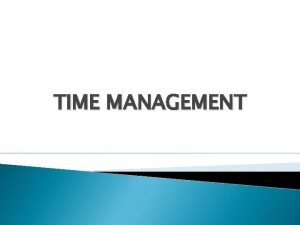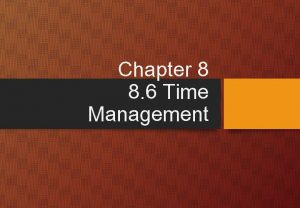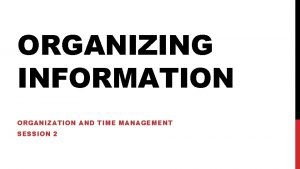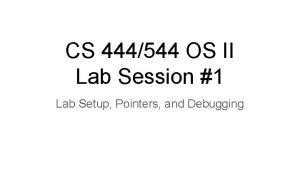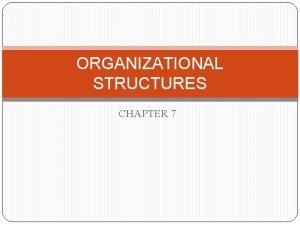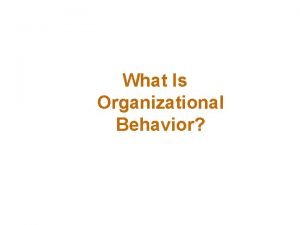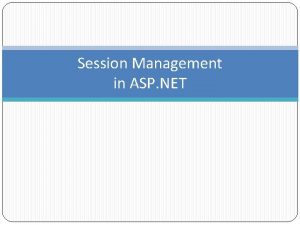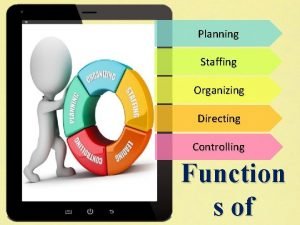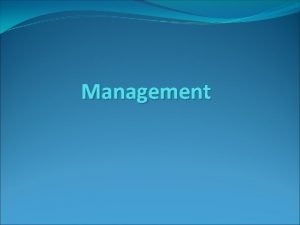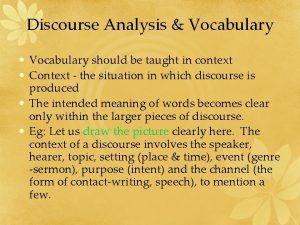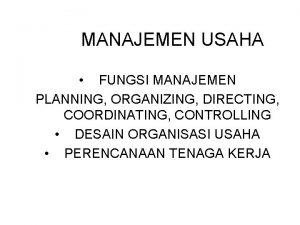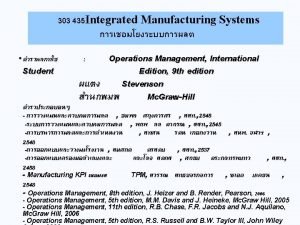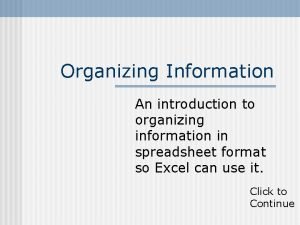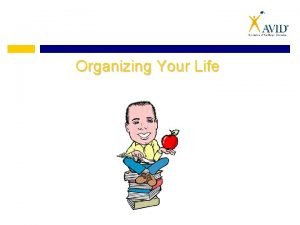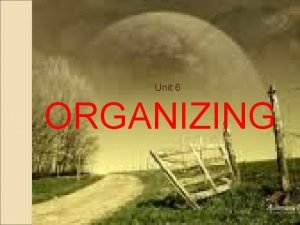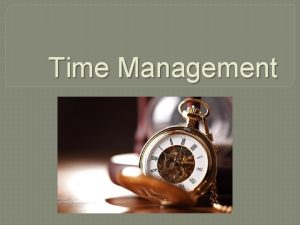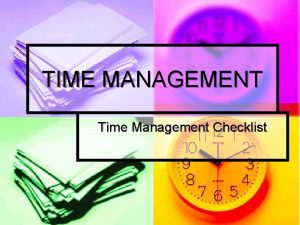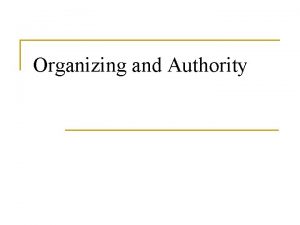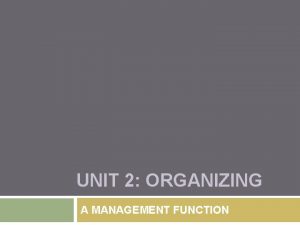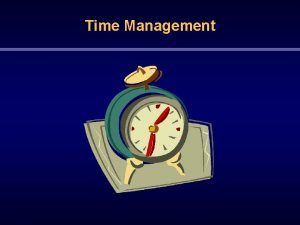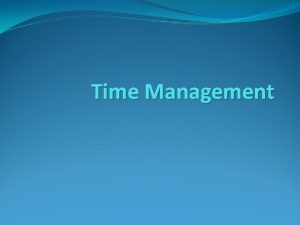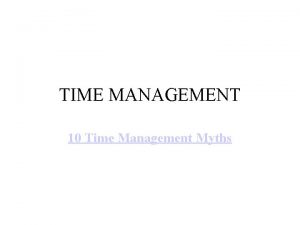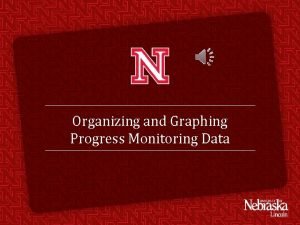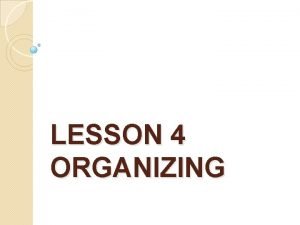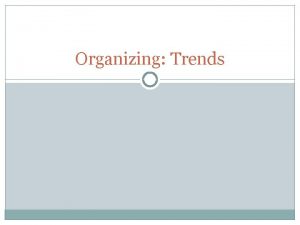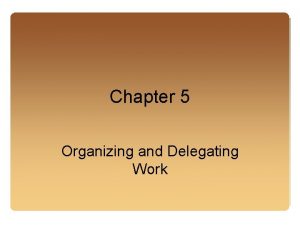ORGANIZING INFORMATION ORGANIZATION AND TIME MANAGEMENT SESSION 2































- Slides: 31

ORGANIZING INFORMATION ORGANIZATION AND TIME MANAGEMENT SESSION 2

IN THIS SESSION WE WILL BE • learning about the LATCH principle for organizing information • practice organizing information in a variety of different ways.

FIVE DIFFERENT WAYS TO ORGANIZE INFORMATION "THE LATCH PRINCIPLE" "LATCH" • Location • Alphabet • Time (chronologically) • Category • Hierarchy Source: http: //www. informit. com/articles/article. aspx? p=130881&seq. Num=6 Richard S. Wurman "Information Anxiety 2"

IN HIS BOOK, RICHARD WURMAN SAYS…. “while information may be infinite, the ways of structuring it are not. And once you have a place in which the information can be plugged, it becomes that much more useful. Your choice will be different understanding of the information-within each are many variations. However, recognizing that the main choices are limited makes the process less intimidating. ”

LATCH- THE ULTIMATE HAT RACK • We already employ the five modes of organization in many different ways. • Most of us organize our financial records first by time, then by category when we figure our taxes. We organize our CD and DVD collections, libraries, and even our laundry certain ways. • Many people get into trouble when they mix the different methods of organization, trying to describe something simultaneously in terms of size, geography, and category without a clear understanding that these are all valid but separate means of structuring information. • Understanding the structure and organization of information helps you to extract value and significance from it. • Understanding the LATCH organizing principles is like having the ultimate hat rack.

FIVE HAT RACKS VIDEO https: //www. youtube. com/watch? v=Tgi 1 JQGHENI

ACTIVITY How are these examples of information organized?

LOCATION • You can organize information by showing a visual depiction of a physical space. • Maps are really common ways to organize by location. • You might also show information on a diagram with labels. • Organizing by location usually requires some sort of visual of an area, thing or place

EXAMPLES OF ORGANIZING BY LOCATION • Maps • Shopping mall directory • Diagrams with labels • Webpage Can you think of any others?

ACTIVITY: LOCATION Complete the activity by using the diagram to answer the questions. Then draw a floor plan of the room we are in right now.

ALPHABETICALLY • Organizing alphabetically works really well if you know the specific terms or topics you are looking for. • The reader or person looking at the information needs to know what they are looking for so they can use alphabetical order to find it. • Alphabetical order is commonly used in books.

EXAMPLES OF ORGANIZING BY ALPHABET • Index in a book (e. g. text book, recipe book) • Dictionary • Telephone book Can you think of any others?

ACTIVITY: ALPHABETICAL ORGANIZATION Fill in the company extension list of employees in alphabetical order by last name.

ORGANIZING BY TIME • Organizing information by time is useful for finding information in a chronological pattern. • An example would be by the months or years when events happen. • Time is also good for showing how things happen over a fixed duration of time.

EXAMPLES OF CHRONOLOGICAL ORGANIZATION (BY TIME) • Timeline of historical events • Facebook timeline of "most recent" events • Calendars • A joke • Instructions to cook something • A flow chart to help show or describe a process Can you think of any others?

ACTIVITY: CHRONOLOGICAL ORGANIZATION Use the template provided to create a timeline for a typical day. You can use today as an example.

CATEGORY • Using categories is the broadest of the five ways to organize information. • You can use categories to organize information in just about any way imaginable. For example: • • • colour, shape, gender, model, price, or any other categories you can think of.

EXAMPLES OF ORGANIZING BY CATEGORY • Grocery store products • Online shopping sites • Office supply storage cabinet at work Can you think of any others?

ACTIVITY: ORGANIZE BY CATEGORY Sort the items from the grocery store flyer into the correct categories.

HIERARCHY • Hierarchies help show one piece of information is connected to another in order of importance or rank. • Hierarchies are used in organizational charts to show who reports to whom. Hierarchy is also used to show scale, like biggest to smallest or heaviest to lightest.

EXAMPLES OF ORGANIZING BY HIERARCHY • Company organization chart • Largest to smallest item • Highest cost to lowest cost • Eye chart Can you think of any others?

ACTIVITY: ORGANIZE BY HIERARCHY Interpret the court system organization chart.

PROVINCES AND TERRITORIES OF CANADA We can use the provinces and territories of Canada to show each type of organization works.

PROVINCES AND TERRITORIES OF CANADA By Location Source: http: //en. wikipedia. org/wiki/Provinces_and_territories_ of_Canada

PROVINCES AND TERRITORIES OF CANADA Alphabetical Order by Name Alberta British Columbia Manitoba New Brunswick Newfoundland Northwest Territories Nova Scotia Nunavut Ontario Prince Edward Island Quebec Saskatchewan Yukon

PROVINCES AND TERRITORIES OF CANADA 1867 • New Brunswick • Nova Scotia • Ontario • Quebec 1870 • Manitoba • Northwest Territories 1871 • British Columbia 1873 • Prince Edward Island 1898 • Yukon 1905 • Alberta • Saskatchewan 1949 • Newfoundland 1999 • Nunavut Time. Chronological by Year of Existence

PROVINCES AND TERRITORIES OF CANADA Provinces Territories Ontario Quebec British Columbia Alberta Manitoba Saskatchewan Nova Scotia New Brunswick Newfoundland Prince Edward Island Northwest Territories Nunavut Yukon By Category. Provinces and Territories

PROVINCES AND TERRITORIES OF CANADA By Hierarchy- largest to smallest population (2014 Stats Canada) Ontario 13, 678, 700 Quebec 8, 214, 700 British Columbia 4, 631, 300 Alberta 4, 121, 700 Manitoba 1, 282, 000 Saskatchewan 1, 125, 400 Nova Scotia 942, 700 New Brunswick 753, 900 Newfoundland 527, 000 Prince Edward Island 146, 300 Northwest Territories 43, 600 Nunavut 36, 600 Yukon 36, 500

ACTIVITY How would you organize the examples?

MILESTONE 14

CREDITS This Power Point was created by Laubach Literacy Ontario. The resources can be downloaded free of charge at www. laubach-on. ca. This Employment Ontario project was funded by the Ontario Government. 2015 All website links were accurate at the time of original distribution-March 2015. All of the images and clip art used in this Power Point are from Clipart. com and Microsoft Office. com.
 Time management is the process of organizing and planning
Time management is the process of organizing and planning 8+8+8 time management
8+8+8 time management Selecting organizing and interpreting information
Selecting organizing and interpreting information Organize information example
Organize information example Elapsed time
Elapsed time Point by point organization essay
Point by point organization essay Alpha kappa alpha graduate chapter letter of invitation
Alpha kappa alpha graduate chapter letter of invitation Absn seattle
Absn seattle Plt information session
Plt information session Wharton leadership ventures
Wharton leadership ventures Parent information session
Parent information session Session time skew detected
Session time skew detected Lattice organizational structure
Lattice organizational structure Ob model
Ob model Process organization in computer organization
Process organization in computer organization Balabit psm
Balabit psm Session tracking in asp.net
Session tracking in asp.net Production, information costs, and economic organization
Production, information costs, and economic organization Production information costs and economic organization
Production information costs and economic organization Planning controlling organizing staffing and directing
Planning controlling organizing staffing and directing Planning organizing leading and controlling
Planning organizing leading and controlling Marzano element 15
Marzano element 15 English paragraph
English paragraph Who are managers
Who are managers Discourse analysis and vocabulary
Discourse analysis and vocabulary Organizing life's diversity section 3 domains and kingdoms
Organizing life's diversity section 3 domains and kingdoms Organizing students to practice and deepen knowledge
Organizing students to practice and deepen knowledge Organizing and delivering a manuscript speech
Organizing and delivering a manuscript speech Entertainment speech outline
Entertainment speech outline Planning organizing directing coordinating controlling
Planning organizing directing coordinating controlling Organizing and outlining your speech
Organizing and outlining your speech Organizing and visualizing variables
Organizing and visualizing variables
